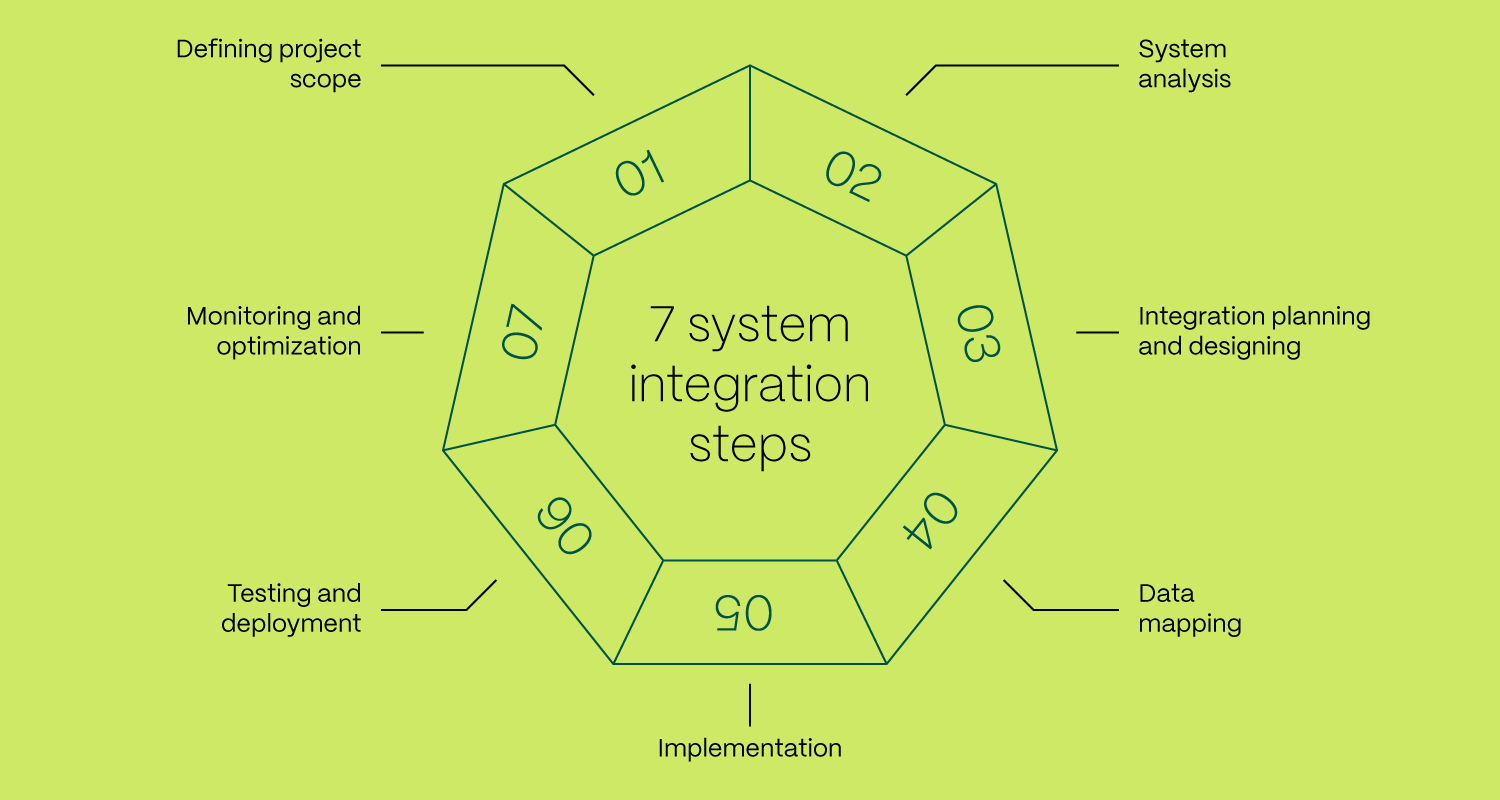The complete guide to enterprise system integration

In the not-so-distant past, businesses were a lot like scattered islands. Each department had its own system and was unaware of what was happening outside it. The communication between these systems was slow and unreliable, which led to operational silos.
In the 1990s, the need for different software applications to talk to each other increased. First attempts to build communication bridges between apps emerged but needed to be more sustainable.
However, these first point-to-point integrations made way for more sophisticated solutions such as on-premise Enterprise Service Bus (ESB), the cloud-based Integration Platform as a Service (iPaaS), and finally – various hybrid solutions for enterprise system integration.
Enterprise system integration can be truly transformative for large organizations. Read our complete guide to understand how system integration can positively impact your revenue growth and improve efficiency by removing silos from the equation.
What is enterprise system integration?
Enterprise system integration allows you to have a single governance model for multiple applications. It's about connecting, coordinating, and optimizing the flow of information between various systems within a company. This includes apps, data, clouds, APIs, processes, and devices.
We continue to see that many organizations consider enterprise integration among their top priorities. There is high awareness about the importance of integrating systems on an enterprise level, and that’s because the trade-off is so good. Sure, there is an upfront investment needed, but in the long term, it keeps paying off.
What is a system integrator?
A system integrator is an expert or a team of experts who build computing systems for clients. They connect the enterprise system with different software systems and platforms from multiple vendors to minimize costs and ensure better efficiency within the company. Affordable, pre-configured components can be used in conjunction with commercial out-of-the-box software and custom solutions built to satisfy enterprise needs.
System integrators are there to design, implement, and test the integration solution. This can involve projects of different complexity, starting from simple internal point-to-point connections to very complex many-to-many integrations both internally and with third parties.
Types of enterprise system integration
Typically, there are four main types of enterprise system integration. In the table below, you can learn more about this.
| Type of enterprise system integration |
Description |
Example |
Benefits |
Legacy system integration |
Connects APIs both on-premises and over the cloud, unifying the system. |
Legacy CRM system gets integrated with a cloud-based communication platform. |
Improved customer relationships, easy real-time collaboration, streamlined communication, and better response times. |
Enterprise application integration (EAI) |
Unites app databases and workflows in an organization, allowing them to work seamlessly together. |
In financial departments, accounting, billing, CRM, human capital management (HCM), supply chain management (SCM), and enterprise resource planning (ERP) can all be connected. |
Thanks to real-time data exchange and cohesive workflows, businesses can keep a bird’s eye view of everything and make better decisions. |
Third-party system integration |
Connecting and incorporating third-party software into your existing system. |
In eCommerce, businesses might choose to integrate a cloud-based payment processor developed by a third party. |
Streamlined checkout process, good security, advanced payment features, and a seamless experience for customers. |
Business-to-business integration |
Connecting and automating business processes and data within a company (or several companies). |
When a manufacturer sends a purchase order to a supplier using standard formats (EDI or XML), the system on the supplier’s side automatically processes it and creates a digital invoice. |
Improved operational excellence, more efficient collaboration, and faster transaction processing. |
System integration vs software development
System integration and software development imply two completely different processes, but they can overlap depending on the project. It’s best if we compare them head-to-head so that you can clearly see the difference.
System integrations
One example of a system integration is connecting a customer relationship management (CRM) system with an enterprise resource planning (ERP) system to share customer data efficiently. These two systems are communicating with one another – and this is powerful for customer-facing teams. There is immediately available context and information, centralized in one place.
Software development
On the other hand, software development is about creating new software applications or building upon or improving existing ones. It revolves around coding, designing, and testing software to meet set requirements. Let’s say that in the above example, we’re talking about an eCommerce company. This company might decide to create a custom Order Management System (OMS) and that would require developing software from scratch.
It’s not necessarily an “either-or” question
Integration systems are part of software development, and we often integrate with existing systems to avoid building functionality from scratch that the system already provides. This results in immediate cost savings. Integration is significantly less expensive than developing an entire system from scratch.
For example, something we frequently integrate with is payment processors. This not only ensures fast online payments but also provides necessary data and transaction security while borrowing their credibility.
How integrated software systems are accelerating revenue growth
If you’re wondering how integrated software systems help large companies, it really comes down to one word–speed. According to PwC research, top-performing companies have one key thing in common – their ecosystems are strongly associated with their success. As a matter of fact, they are more than twice as likely to generate greater than 60% of their revenues from ecosystems.
The way you work from a technical standpoint, correlates directly with how successful your company will be. Just think about the benefits of integrating sales, marketing, finance, and customer service operations. You get systems that efficiently communicate with one another and much more visibility. That’s how you can see the bigger picture and act on data, instead of getting blinded by it.
Benefits of enterprise system integration
Besides better access, improved efficiency, and increased productivity, there are other benefits of enterprise system integration.
- Product offerings with a stronger value proposition: You can easily gather insights from customer interactions, sales data, and market trends. This is how you better understand their behavior and expectations, identify patterns for timely and relevant offers, and more.
- Cost savings: When you consolidate your disparate systems, you are centralizing all your efforts in one place. This reduces the maintenance costs. With the increase in process efficiency and more rational resource use, you get more room to plan and allocate budget to business development.
- Faster time to market: Professionals waste so much time chasing data across fragmented systems that they don’t have the time or focus to work on what matters. Enterprise system integration eliminates this issue and therefore brings all stakeholders on the same page. Time-to-resolution gets faster, development and testing get faster, and therefore – you launch faster.
- Automate and streamline processes: Because there is a seamless flow of data between connected systems, you don’t have to intervene as much. It’s almost as if you “set it and forget it” – you enjoy the power of having a unified view of everything.
- Reduced bottlenecks: Because all processes get streamlined, communication lines open, and workflows automated, people get blocked less, and potential issues are spotted even before they occur.
Challenges of system integration
Challenges of system integration can be categorized into two main buckets. One is related to internal factors (change management, lack of expertise), and the other is related to the technical aspect of the integration. Here is a full list of the most common challenges:
- connecting to monolithic and legacy systems
- change management on an organizational level
- the lack of resources and expertise
- data incompatibility
- ensuring scalability and security compliance
The best way to tackle this is to follow best practices and make sure you have experienced tech experts guiding you through.
System integration best practices
System integration best practices may vary from company to company. A lot of moving parts and multiple layers of complexity introduce a risk of cost overruns and delays in the integration process, and each business case is unique.
Based on our experience of almost two decades, we have developed a list of things that need to fall into place to have a successful integration project:
- Involve all key stakeholders.
- Create an integration strategy .
- Ensure flexibility and scalability of the system integration architecture.
- Test thoroughly.
- Document everything.
|
Want to learn more? Read our guide to system integration best practices to make sure you have a futureproof plan moving forward. |
System integration steps
While every company might follow its unique system integration process, some are universal and cannot be skipped. Below is a visual that outlines all the steps in the process.
Generative AI integrations
Generative AI tools like ChatGPT or Gemini look very promising, but how can enterprises bring them inside their organizations? There is a certain dose of anxiety surrounding the generative AI craze, coupled with the fear of missing out and getting behind the competition.
However, because the way this technology can be applied is still a puzzle for enterprises, executives shy away from it or deprioritize it. The return on investment is often unclear, and the fear of exploiting sensitive data outweighs the benefits. That was before solutions like the artificial intelligence integration platform as a service (AI iPaaS) emerged.
Artificial intelligence integration platform as a service (AI iPaaS) helps minimize the risk of human error, automates steps in the process, and empowers the platform to “learn” over time and self-optimize. The possibilities are endless.
Find a reliable enterprise system integration partner
Enterprise system integration can help you optimize workflows, improve data quality, and increase efficiency across all departments. It’s an initial investment that brings long-term cost savings. This applies, of course, if you do it the right way. That’s why it’s important to find the right partner who can support you with technical expertise for smooth system integration.
With Vega IT, you can make your enterprise systems run like clockwork and unlock new business opportunities with the right software integration. We partner with our clients and offer software integration consultations, software architecture, data migration, API development, or API connection. Get in touch with us today, and we’ll help you transform your business from within.







